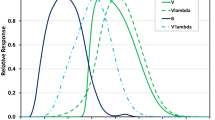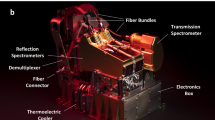Abstract
SARAS is a correlation spectrometer purpose designed for precision measurements of the cosmic radio background and faint features in the sky spectrum at long wavelengths that arise from redshifted 21-cm from gas in the reionization epoch. SARAS operates in the octave band 87.5–175 MHz. We present herein the system design arguing for a complex correlation spectrometer concept. The SARAS design concept provides a differential measurement between the antenna temperature and that of an internal reference termination, with measurements in switched system states allowing for cancellation of additive contaminants from a large part of the signal flow path including the digital spectrometer. A switched noise injection scheme provides absolute spectral calibration. Additionally, we argue for an electrically small frequency-independent antenna over an absorber ground. Various critical design features that aid in avoidance of systematics and in providing calibration products for the parametrization of other unavoidable systematics are described and the rationale discussed. The signal flow and processing is analyzed and the response to noise temperatures of the antenna, reference termination and amplifiers is computed. Multi-path propagation arising from internal reflections are considered in the analysis, which includes a harmonic series of internal reflections. We opine that the SARAS design concept is advantageous for precision measurement of the absolute cosmic radio background spectrum; therefore, the design features and analysis methods presented here are expected to serve as a basis for implementations tailored to measurements of a multiplicity of features in the background sky at long wavelengths, which may arise from events in the dark ages and subsequent reionization era.



















Similar content being viewed by others
References
Bartlett, J.G., Stebbins, A.: Did the universe recombine? Astrophys. J. 371, 8–13 (1991)
Bowman, J.D., Rogers, A.E.E.: A lower limit of Δz > 0.06 for the duration of the reionization epoch. Nature 468, 796–798 (2010)
Burigana, C., Danese, L., de Zotti., G.: Formation and evolution of early distortions of the microwave background spectrum—A numerical study. Astron. Astrophys. 246, 49–58 (1991)
Burns, J.O., Lazio, J., Bale, S., Bowman, J., Bradley, R., Carilli, C., Furlanetto, S., Harker, G., Loeb, A., Pritchard, J.: Probing the first stars and black holes in the early Universe with the Dark Ages Radio Explorer (DARE). Adv. Space Res. 49, 433–450 (2012)
Chippendale, A.P.: Detecting cosmological reionization on large scales through the 21 cm HI line, pp. 1–204. Ph.D. Thesis, University of Sydney, School of Physics (2009)
Clark, T.A., Brown, L.W., Alexander, J.K.: Spectrum of the extra-galactic background radiation at low radio frequencies. Nature 228, 847–849 (1970)
Condon, J.J., Cotton, W.D., Fomalont, E.B., Kellermann, K.I., Miller, N., Perley, R.A., Scott, D., Vernstrom, T., Wall, J.V.: Resolving the radio source background: deeper understanding through confusion. Astrophys. J. 758, 23–36 (2012)
Dicke, R.H., Peebles, P.J.E., Roll, P.G., Wilkinson, D.T.: Cosmic Black-Body radiation. Astrophys. J. 142, 414–419 (1965)
Fan, X., Strauss, M.A., Becker, R.H., White, R.L., Gunn, J.E., Knapp, G.R., Richards, G.T., Schneider, D.P., Brinkmann, J., Fukugita, M.: Constraining the evolution of the ionizing background and the epoch of reionization with z 6 Quasars. II. A sample of 19 Quasars. Astron. J. 132, 117–136 (2006)
Field, G.B.: Excitation of hydrogen 21-cm line. Proc. IRE 46, 240–250 (1958)
Fixsen, D.J., Kogut, A., Levin, S., Limon, M., Lubin, P., Mirel, P., Seiffert, M., Singal, J., Wollack, E., Villela, T., Wuensche, C.A.: ARCADE 2 measurement of the absolute sky brightness at 3–90 GHz. Astrophys. J. 734, 5–11 (2009)
Fornengo, N., Lineros, R., Regis, M., Taoso, M.: A dark matter interpretation for the ARCADE excess? Phys. Rev. Lett. 271302, 107 (2011)
Harker, G.J.A., Pritchard, J.R., Burns, J.O., Bowman, J.D.: An MCMC approach to extracting the global 21-cm signal during the cosmic dawn from sky-averaged radio observations. MNRAS 419, 1070–1084 (2012)
Haslam, C.G.T., Salter, C.J., Stoffel, H., Wilson, W.E.: A 408 MHz all-sky continuum survey. II—The atlas of contour maps. Astron. Astrophys., Suppl. Ser. 47, 1–142 (1982)
Hinshaw, G., Larson, D., Komatsu, E., Spergel, D.N., Bennett, C.L., Dunkley, J., Nolta, M.R., Halpern, M., Hill, R.S., Odegard, N., Page, L., Smith, K.M., Weiland, J.L., Gold, B., Jarosik, N., Kogut, A., Limon, M., Meyer, S.S., Tucker, G.S., Wollack, E., Wright, E.L.: Nine-Year Wilkinson Microwave anisotropy probe (WMAP) observations: cosmological parameter results. Astrophys. J., Suppl. Ser. (2013). ArXiv:1212.5226
Jansky, K.G.: Radio waves from outside the solar system. Nature 132, 66 (1933)
Kogut, A., Fixsen, D.J., Levin, S.M., Limon, M., Lubin, P.M., Mirel, P., Seiffert, M., Singal, J., Villela, T., Wollack, E., Wuensche, C.A.: ARCADE 2 observations of galactic radio emission. Astrophys. J. 734, 4–12 (2011)
Landecker, T.L., Wielebinski, R.: The Galactic Metre Wave Radiation: A two-frequency survey between declinations +25° and −25° and the preparation of a map of the whole sky. Aust. J. Phys., Astrophys. Suppl. 16, 1–30 (1970)
Larson, D., Dunkley, J., Hinshaw, G., Komatsu, E., Nolta, M.R., Bennett, C.L., Gold, B., Halpern, M., Hill, R.S., Jarosik, N., Kogut, A., Limon, M., Meyer, S.S., Odegard, N., Page, L., Smith, K.M., Spergel, D.N., Tucker, G.S., Weiland, J.L., Wollack, E., Wright, E.L.: Seven-year Wilkinson Microwave Anisotropy Probe (WMAP) observations: Power spectra and WMAP-derived parameters. Astrophys. J. Suppl. Ser. 192, 16–34 (2011)
Greenhill, L.J., Bernardi, G.: HI Epoch of Reionization Arrays. In: Komonjinda, S., Kovalev, Y., Ruffolo, D. (eds.) 11th Asian-Pacific Regional IAU Meeting 2011, NARIT Conference Series 1. Bangkok, NARIT (2012)
de Oliveira-Costa, A., Tegmark, M., Gaensler, B.M., Jonas, J., Landecker, T.L., Reich, P.: A model of diffuse Galactic radio emission from 10 MHz to 100 GHz. MNRAS 388, 247–260 (2008)
Penzias, A.A., Wilson, R.W.: A measurement of excess antenna temperature at 4080 Mc/s. Astrophys. J. 142, 419–421 (1965)
Pritchard, J.R., Loeb, A.: Evolution of the 21 cm signal throughout cosmic history. Phys. Rev. D 103511(1–16), 78 (2008)
Pritchard, J.R., Loeb, A.: Constraining the unexplored period between reionization and the dark ages with observations of the global 21 cm signal. Phys. Rev. D 82(023006), 1–12 (2010)
Raghunathan, A., Udaya Shankar, N., Subrahmanyan, R.: An octave bandwidth frequency independent dipole antenna. IEEE Trans. Antennas Propag. (2013, accepted)
Rogers, A.E.E., Bowman, J.D.: Spectral index of the diffuse radio background measured from 100 to 200 MHz. Astron. J. 136, 641–648 (2008)
Rogers, A.E.E., Bowman, J.D.: Absolute calibration of a wideband antenna and spectrometer for accurate sky noise temperature measurements. Radio Sci. 47, RS0K06 (2012). doi:10.1029/2011RS004962
Shaver, P.A., Windhorst, R.A., Madau, P., de Bruyn., A.G.: Can the reionization epoch be detected as a global signature in the cosmic background? Astron. Astrophys. 345, 380–390 (1999)
Seiffert, M., Fixsen, D.J., Kogut, A., Levin, S.M., Limon, M., Lubin, P.M., Mirel, P., Singal, J., Villela, T., Wollack, E., Wuensche, C.A.: Interpretation of the ARCADE 2 absolute sky brightness measurement. Astrophys. J. 734, 6–13 (2011)
Singal, J., Stawarz, L., Lawrence, A., Petrosian, V.: Sources of radio background considered. MNRAS 409, 1172–1182 (2010)
Sunyaev, R.A., Zeldovich, Y.B.: The spectrum of primordial radiation, its distortions and their significance. Comments Astrophys. Space Phys. 2, 66–74 (1970)
Vernstrom, T., Scott, D., Wall, J.V.: Contribution to the diffuse radio background from extragalactic radio sources. MNRAS 415, 3641–3648 (2011)
Wouthuysen, S.A.: On the excitation mechanism of the 21-cm (radio-frequency) interstellar hydrogen emission line. Astron. J. 57, 31–32 (1952)
Zahn, O., Reichardt, C.L., Shaw, L., Lidz, A., Aird, K.A., et al.: Cosmic microwave background constraints on the duration and timing of reionization from the south pole telescope. Astrophys. J. 756, 65–80 (2012)
Acknowledgments
The development of the SARAS concept has benefited greatly from the contemporaneous experimentation with implementations and trials of a variety of system configurations, which received outstanding support from staff of the Gauribidanur Radio Observatory and the Electronics Laboratory and Mechanical Engineering services at the Raman Research Institute. We thank Ron Ekers for his encouragement and participation in the effort.
Author information
Authors and Affiliations
Corresponding author
Rights and permissions
About this article
Cite this article
Patra, N., Subrahmanyan, R., Raghunathan, A. et al. SARAS: a precision system for measurement of the cosmic radio background and signatures from the epoch of reionization. Exp Astron 36, 319–370 (2013). https://doi.org/10.1007/s10686-013-9336-3
Received:
Accepted:
Published:
Issue Date:
DOI: https://doi.org/10.1007/s10686-013-9336-3




